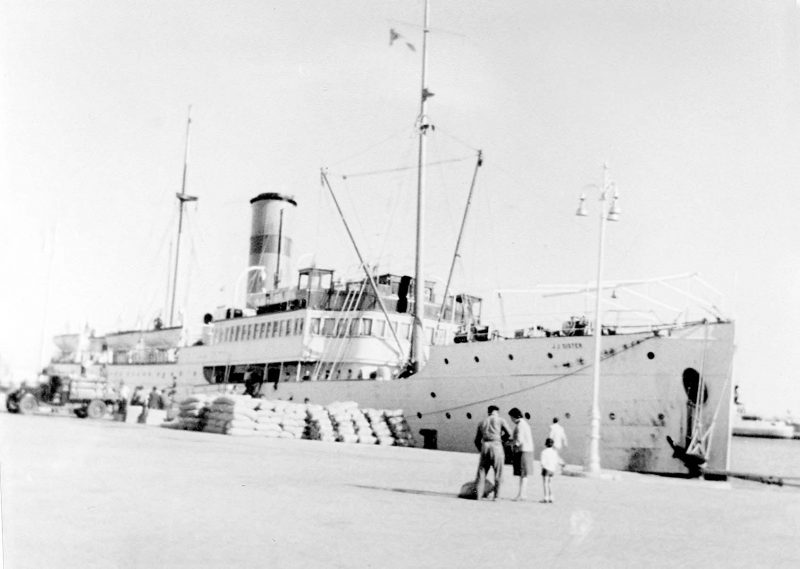
La Tras is the colloquial name that Spanish people use for their much loved national ferry line. New Years Day of 2017 was the centenary anniversary of the first day that their Spanish national ferry line began to run services to its many destinations including the Balearics, Ceuta and Melilla in North Africa, the Canaries, and the Spanish colonies of Fernando Po and Spanish Guinea in West Africa. Nine small companies came together on that day one hundred years ago, namely Maritima Barcelona, Gijonesa, La Islena Maritima, Menorquina, Navegaceon y Industria, Tintore (founded by Pablo M. Tintore in Barcelona in 1852), Valenciana and Vinuesa fleets. The actual instrument and deed of the constitution of Compania Trasmediterranea was signed in Barcelona before the Public Notary Antonio Sasot Mejias on 25th November 1916 by Joaquin Maria Tintore of Linea de Vapores Tintore, Enrique Garcia Corrons of Navegaceon y Industria S.A., Jose Juan Domine of Compania Valenciana de Vapores Correos de Africa, and Vicente Ferrer Pesset on behalf of Ferrer Pesset Hermanos companies.
THE EARLY YEARS
The new company had a large fleet of 44 passenger and cargo ships to call on, mostly small steamers, but the first task was to analyse how these disparate fleets would fit into a national plan. A network of mail, passenger and cargo services was worked out that linked all of the coastal islands and the enclaves of Ceuta and Melilla in Northern Africa, but also the long range services to the seven Canary Islands and the two possessions in the Gulf of Guinea at a long distance from Spain. A fine trio of twin screw Italian built sisters dating from 1896 as Cristoforo Colombo, Galileo Galilei and Marco Polo, were purchased in 1912 by La Roda Hermanos and transferred to Valenciana in 1914, and given the names A. Lazaro, J.J. Sister and V. Puchol after the founders of the Valenciana company. They had dimensions of length 281.7 feet, moulded beam of 36.7 feet and depth of 18.7 feet with fo’c’tle and poop, and were frequently used from Malaga to Ceuta and Melilla and had accommodation for sixty First Class passengers and many day deck passengers and just over one thousand tonnes of cargo, mostly potatoes.
The priority was to modernise this elderly fleet, and this was achieved initially by re-engining old ships with ten cylinder M.A.N. diesels from 1922 onwards, including the Valenciana trio dating from 1896. After the end of World War I, there was a big demand for passenger services between Spain and the U.S.A., and during 1920/21 the company made ten sailings between Barcelona and New York with calls at other Spanish ports. On special occasions, company ships have also sailed as far as the Caribbean and South America, the Phillipines and the Red Sea. The company operated to Fernando and Spanish Guinea for sixty years, and tourist cruises were also offered to many Mediterranean ports, the Holy Land, France and to England. In the summer of 1933, 188 students embarked on the passenger vessel Ciudad de Cadiz for a cruise lasting 45 days under the protection of La Institucion Libre de Ensenanza y Promovido (Free Institute for Teaching and Promotion) of the Faculty of Letters and Philosophy of Madrid Central University. This university cruise called at ports in Tunisia, Malta, Egypt, Palestine, Turkey, Greece and Italy with the central objective of learning about European civilisations. A few more voyages to New York were made during 1940/41, and Ciudad de Sevilla made one round voyage to Philadelphia in 1944.

The white hulled, counter sterned, twin masted fleet of La Islena Maritima serving the Balearic islands from Valenciana and Barcelona were always smart and spotless in their appearance and much loved by Spanish people travelling to the islands. Streamers were not available or could not be afforded in the early days for passengers to wave to their loved ones as the ships left port, so toilet rolls were a good substitute. Mallorca of 2,223 grt built and completed in November 1914 at Sestri Ponente near Genoa was the flagship with a second deck in her holds and was powered by a triple expansion steam engine manufactured by her builders. The steamers Rey Jaime I from the same yard at Sestri Ponente in 1911 and Rey Jaime II from Swan, Hunter on the Tyne in 1906 also sailed from Valencia to Palma on Mallorca, Mahon on Menorca, or Ibiza Town.
Notable black hulled cargo ships in the early fleet included Escolano 3,058/19, the engines aft Atalante 1,446/94, Romeu 3,070/18, and the twin screw Legazpi 4,349/04. There were fifteen motor vessels in the fleet by 1930, namely A. Lazaro, Ciudad de Algeciras, Ciudad de Alicante, Ciudad de Barcelona, Ciudad de Cadiz, Ciudad de Ceuta, Ciudad de Mahon, Ciudad de Malaga, Ciudad de Palma, Ciudad de Sevilla, Ciudad de Valencia, J.J. Sister, Jativa, V. Puchol and Villa de Madrid. Jativa had been built back in 1880 at the John Readhead yard at South Shields and was the first steamer to be converted to a motorship in 1922 when she was re-engined with four cylinder diesels manufactured at Amsterdam, and she served for another eleven years until broken up. Most of the new ‘Ciudad’ motor vessels were used on the Balearics services including five smaller passenger and cargo ships completed around 1929/30 by Italian yards as Ciudad de Palma, Ciudad de Alicante, Ciudad de Ibiza, Ciudad de Tarragona and Ciudad de Valencia.
A change of policy to new and bigger motor passenger liners had occurred in 1928 with the first of four liners of around 6,900 grt. Infanta Beatriz was built by Krupp A.G. at Kiel, and her twin propellers were powered by two powerful six cylinder Krupp diesels to give a service speed of fourteen knots. This first liner of the quartet was given twin funnels, the others had only one motor ship funnel. They could carry around 135 passengers in First Class, 38 in Second Class and 60 in Third Class, with a crew of one hundred on their services to the Canaries and West Africa. Infanta Beatriz was renamed Ciudad de Sevilla in 1931, and her sisters were Villa De Madrid of 1931, Domine of 1935 and Fernano Po of 1935, the last pair built at Bilbao.
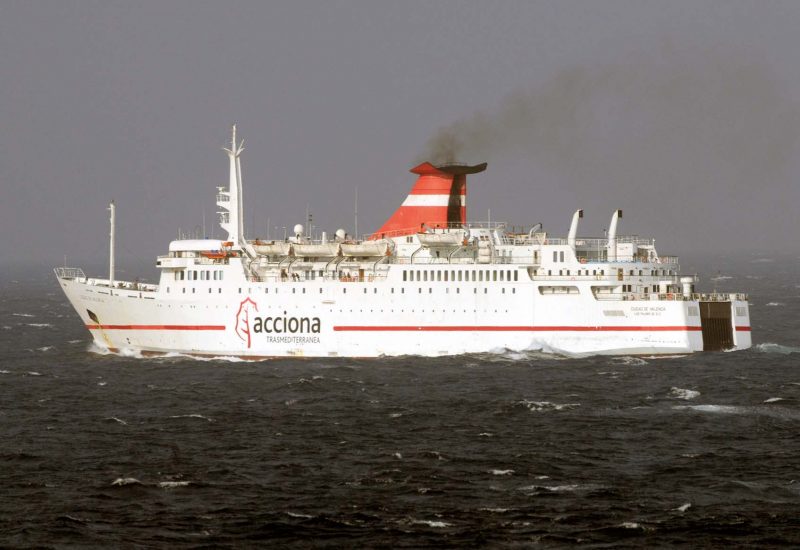
The seven vessel fleet of Compania de Vapores Correos Interinsulares Canarios of Las Palmas on Gran Canaria was transferred to the ownership of Compania Trasmediterranea during 1930/32. This was a subsidiary of Elder, Dempster of Liverpool and the fleet of Viera y Clavijo, Leon y Castillo, La Palma, Lanzarote, Fuerteventura, Gomera and Hierro brought fruit and general cargo into Santa Cruz de Tenerife and Las Palmas de Gran Canaria for shipment on the big Elder, Dempster vessels to the U.K. La Palma was one of the last trio to be withdrawn from service in 1977, and was used from 1982 as a yacht club and restaurant in Santa Cruz de Tenerife, and fortunately has been recently preserved and lies today at the side of the no longer used Stacion Maritima in that port.
SPANISH CIVIL WAR
On 17th July 1936, simultaneous uprisings occurred across Spain led by General Francisco Franco, who was Commander of the Spanish Army in the Canary Islands and who flew north to take charge of the Spanish Foreign Legion in Morocco, and by General Emiliano Mola on mainland Spain. The Spanish Government was panicked into inaction, and worker militias took charge of many towns, but a large part of the Spanish Army remained loyal to the Republican side of the conflict. The Nationalist side, under General Francisco Franco, had the advantage of German transport planes to fly their Moroccan forces into Southern Andalucia, and then waged a slow, three year war against the Republicans in a clockwise war taking eastern Andalucia, Extremadura, Northern Spain including the Basque country, Barcelona and Catalonia, Valencia, and then marched into the capital of Madrid through its shattered university district in March 1939 to end the war.

The Trasmediterranea fleet was also almost split down in the middle to participate on the Republican or Nationalist sides of this brutal conflict, in which hundreds of thousands died, sometimes with one brother of a family taking the Republican side and another brother taking the Nationalist side and both dying for their cause. Italian troops arrived on the Spanish mainland to help Franco and the Nationalists, while the Republican side was helped by Russian arms and supplies sent by sea to the Spanish eastern Mediterranean coast. The International Brigade was formed with largely British and European volunteers to fight for the Republican side in the bloody battles against the Nationalists.
The Trasmediterranea ships that took the Republican side included the liner Fernando Po, sunk in October 1936 off Bata in Spanish Guinea by the Nationalist auxiliary cruiser Ciudad de Mahon. Ciudad de Sevilla her sister, was bombed and sunk at Barcelona in January 1939 but was raised, repaired and re-commissioned and continued in service until broken up in 1966. Two more sisters of this quartet of liners, Domine and Villa de Madrid, served as Nationalist and Republican Auxiliary Merchant Cruisers, with Villa de Madrid sunk by Nationalist air attack at Barcelona in January 1939, but was refloated and repaired. Aragon was stopped by a German pocket battleship in the Straits of Gibraltar while operating on behalf of the Nationalists and was handed over to them. J. J. Sister served the Republicans as a prison ship for a year until 1937, when she was captured by the Nationalist cruiser Canarias. Delfin stranded at Malaga on 21st January 1937 and was subsequently destroyed by Nationalist air attack. Ciudad de Cadiz was torpedoed and sunk in the Aegean on 15th August 1937 by the Italian submarine Ferraris while transporting Russian aid to the Republicans. Rey Jaime I was seized by the Nationalists in 1936 and transferred to the Italian flag and renamed Buccari and converted to an auxiliary cruiser, but was returned to her owners in 1939 and sailed on until scrapped in 1968. Rey Jaime II was captured by the Nationalist cruiser Canarias on 16th February 1937 and converted to an auxiliary cruiser, but was returned to her owners in 1939 and sailed until scrapped in 1963.
The Trasmediterranea ships that took the Nationalist side included the passenger and cargo ship A. Lazaro, which was converted to a minelayer and auxiliary cruiser, and her sister V. Puchol which also became an auxiliary cruiser. Several other vessels became auxiliary cruisers for the Nationalists, including Mallorca, Infante D. Juan and Ciudad de Palma, and the Nationalist forces sank more Republican Trasmediterranea ships during the two year period from March 1937 to March 1939 including Ciudad de Barcelona, Isla de Menorca, Legazpi and Mahon. The Balearics islands were split in their allegiances, with Palma and Mallorca taking the Nationalist side, and Mahon and Menorca taking the Republican side. Mahon and Menorca finally surrendered to the Nationalists in early 1939, and this terrible war, which had seen the atrocities of aerial dive bombing by the German Stukas of the Condor Division of the Luftwaffe of the civilian population of the Basque town of Guernica, immortalised in the painting by Picasso, finally came to an end.

POST-WAR YEARS
The shattered Trasmediterranea fleet was gradually raised from the harbours of all of the Spanish ports and repaired and put back into service. The fleet was also augmented in 1939 by 37 cargo ships and 1 tanker seized by the Spanish Government in Spanish ports during the Civil War and given ‘Castillo’ names e.g. Castillo Simancas, built in 1907 as Den of Ruthven by Charles Connell on the Clyde, and transferred in 1942 to Empresa Nacional ‘Elcano’, the Spanish National Line. The last company steamer, Plus Ultra of 4,312 grt and completed in May 1928 by the Union Navale de Levante yard at Valencia served on the Canaries route carrying general cargo and potatoes until eventually arriving for breaking up at San Esteban de Pravia near Aviles and Gijon on the north coast of Spain in June 1977. The sister steamers Isla de Tenerife and Isla de Gran Canaria of 5,120 grt built in 1921 at Bilbao by Compania Naval de Construcciones and purchased seven years later, lasted until the early 1970s. This had been greatly helped by Isla de Tenerife being laid up on the Tyne from October 1936 for the three year length of the Spanish Civil War, with her sister safely moored in another North European port.
Although theoretically neutral during World War II, Franco had given great help and tacit approval to Fascist Germany, and thus in 1946 Spain was forced to rebuild her fleets using her own steel plants and shipyards as no other shipyards in the Western world would build them. The first unit of the rebuilding programme was an unlikely candidate in the wreck of the DFDS passenger motorship Esbjerg, one of a quartet of sisters used on the Harwich to Esbjerg route with sister Parkeston used on the Newcastle to Esbjerg route. Esbjerg had been mined and sunk off Stevns on 29th July 1945 and although raised was found not worthy of repair. Her shattered hull was sold to Tradmediterranea and towed to Valencia in August 1947 to be totally rebuilt. She was renamed Ciudad de Ibiza and served the Valencia to Ibiza route for the next thirty years. She was broken up at the end of 1978 at Villanueva y Geltru, and parts of her bow and stern were saved for public display at Museo Maritimo Roig Toiqs beside the fashionable resort of Sitges near Barcelona.

The passenger and cargo vessel Ciudad de Alcira of 2,518 grt was completed in 1946 as Alcira, and was renamed in the following year. The twin screw Ciudad de Cadiz of 1951 and Ernesto Anastasio of 7,295 grt were two of a class of handy good looking passenger ferries built in Spain during 1948/54, their sisters going mostly to Trasatlantica. They had accommodation for 440 passengers and a good service speed of eighteen knots on the Barcelona to Malaga, Cadiz and Canaries route from twin B & W diesel engines of 7,000 bhp. Ciudad de Cadiz was broken up in 1979 and Ernesto Anastasio was wrecked on the Spanish coast on 24th April 1980 at Bancha del Oeste, Pasajes with the wreck refloated and broken up at Santander in July 1980. Two of the Trasatlantica sisters were purchased by Trasmediterranea in 1973, although only one entered service as Isla de Formentera, the other being destroyed by fire as Isla de Cabrera during a refit.
Four good looking passenger ferries were delivered during 1955/61 by the Valencia yard of Union Navale de Levante as Ciudad de Barcelona, Ciudad de Burgos, Ciudad de Granada and the smaller Ciudad de Tarifa. They were used on the nightly Balearics, and Algeciras to Tangiers routes, and had accommodation for between 400 and 900 passengers. Ciudad de Toledo from the Euskalduna yard at Bilbao in 1956 was a cargo-liner with good cargo capacity and accommodation for 54 passengers, which became a floating exhibition of Spanish industry and visited 31 ports in 16 different countries between August and December 1956. Villa de Bilbao and Ciudad de Pamplona built in 1962/64 were enlarged versions of the four hold cargo ship Ciudad de Oviedo of 1957. Four smaller passenger ferries were the sisters Virgen de Africa and Victoria on the Algeciras to Ceuta service, and the sisters Ciudad de Teruel and Ciudad de Huesca on inter Canaries services.
A ferry had been converted into a side loader ferry in 1951 for the Algeciras to Ceuta route, but the first new car ferries were the ‘Albatros’ class of four side loaders completed in 1966/67. Juan March, named after a company manager from the island of Mallorca, Ciudad de Compostela, and the Canaries ferries Las Palmas de Gran Canaria and Santa Cruz de Tenerife carried 750 passengers on the Barcelona to Palma, Cadiz and Canaries route. Juan March was sold in 1985 and became the cruise ship Ocean Majesty, and Ciudad de Compostela was the last of the class to be sold in 1992, going to Greek owners and sinking after a fire on a Piraeus to Venice voyage in June 1994. Two twin funnelled engines aft sisters were completed in 1969 at Valencia as Antonio Lazaro (2) and Vicente Puchol (2) with accommodation for 600 passengers with service speeds of seventeen knots on the Malaga to Melilla route and later on Balearics routes from Valencia and Alicante.


Antonio Lazaro was sold in 1988 to the Operation Mobility, a Christian charity to promote Christian values around the world, and renamed Logos II with ‘EBE’ on her funnels and sailed for seventeen years in that role until she arrived at Aliaga for breaking up on 3rd October 2008. Her sister Vicente Puchol led a chequered career as a cruise ship with several changes of name including Asian cruising as Coco Explorer 2. Two larger exact sisters were completed at Valencia in 1975 as J. J. Sister (2) and Manuel Soto with accommodation for 712 berthed and 368 deck passengers. They had unusual tops to their funnels and were sold at the end of their Canaries careers to Moby Line of Italy and renamed Moby Magic and Moby Fantasy respectively.
NATIONALISATION OF TRASMEDITERRANEA
A change in livery took place in 1980 on the nationalisation of the fleet, with light green and blue stripes swept back at rakish angles from bridge to stern and ‘Trasmediterranea’ painted along their white hulls. The streamlined light green and blue funnel colours carried the new ‘TF’ company logo. Six ‘Canguro’ class passenger ro-ro ferries joined the fleet between 1979 and 1984 and adopted the new colours as Ciudad de Badajoz, Ciudad de Palma, Ciudad de Santa Cruz de La Palma, Ciudad de Salamanca, Ciudad de Sevilla and Ciudad de Valencia. However, two of this class had been built in 1971 for a joint service between Barcelona and Genoa by Ybarra Line and Traghetti Sardi (Sardinian Ferries). They had accommodation for one thousand passengers and 250 cars.
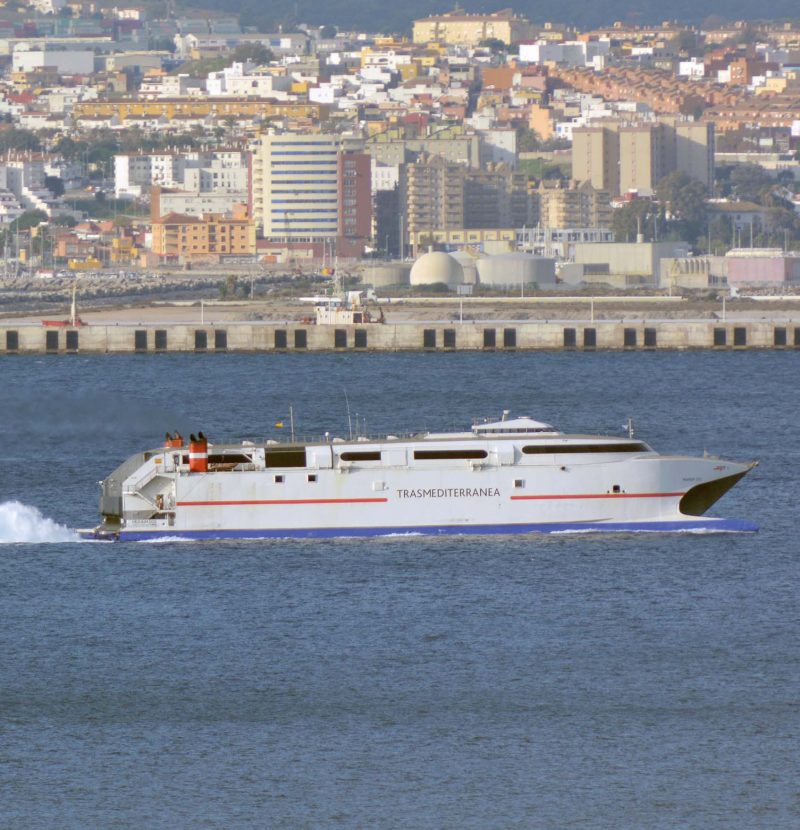
Three ‘Gaviota’ class ships with accommodation for 1,300 passengers and 160 cars were Ciudad de Algeciras, Ciudad de Ceuta and Ciudad de Zaragoza, two of this trio having been purchased from Aznar Line in 1978. Two good looking sisters were purchased in 1975 from Finnish owners and renamed Ciudad de la Laguna and Villa de Agaete and operated Canarian inter island routes. Ciudad de la Laguna was sold to Armas Ferries in 1999 as the excursion ship Volcan de Tenagua, and Villa de Agaete was sold to Iscomar of Spain in 2002 and renamed Carmen del Mare. They had been built in 1967 and 1970 respectively as Botnia for A/B Bore and Floria for Finland Line. I personally had the pleasure of a ‘Round Island’ day excursion around the island of Gran Canaria on Volcan de Tenagua.
In 1990, the national ferry line had a fleet of forty ships, but there was pressure from other ferry companies e.g. Isnasa (Islena de Navegacion) operating four ferries providing eight daily services on the Algeciras to Ceuta route, six to Tangiers and one from Tarifa to Tangiers. Moroccan and Fred. Olsen owned ferries were also operating from Algeciras to Tangiers. Thus, Trasmediterranea commissioned larger new ferries to compete and they began arriving from shipyards in 1993. The white hulled flagship Juan J. Sister (3) of 22,409 grt came from the Helsinki yard of Kvaerner Masa for the Cadiz to Tenerife route with accommodation for 550 cabin passengers and 250 cars. This route was also served by the white hulled passenger ro-ro sisters Santa Cruz de Tenerife (2) and Las Palmas de Gran Canaria (2) of 10,470 grt with accommodation for 400 unberthed passengers and 280 cars. Two further large passenger ferries of 26,916 grt were completed by Hijos Barreras of Vigo and the Izar yard at Puerto Real as Sorolla and Fortuny for the Barcelona to Palma route during 2001/03. They have accommodation for 1,100 passengers and 336 cars, and operated on the overnight main route to Mallorca in each direction at 23 knots for some years. The ro-paxes Alyssa and Northern Merchant were chartered during 2000/01 while the two superferries were under construction. The similar sized, but of ro-pax design, Murillo of 25,028 grt was built a year later by the Izar yard at Seville for the route to Arrecife on Lanzarote.
The company ro-ro freight vessels were given black hulls and included Cala Llonga, named after a Menorcan cove, Cala Fustan, Cala Salada, Ciudad de Alicante, Ciudad de Burgos, Ciudad de Cadiz and Ciudad de Ceuta in the 1990s. Three freight ro-ros had been purchased from Interoll S.A. in the 1980s and renamed as Ciudad de Alicante, Ciudad de Burgos (chartered at first and then purchased), and Ciudad de Cadiz. The freight services were enhanced by the purchase of two new Fred Olsen freight ro-ro ferries Bayard and Brabant in 1998, renamed Super Fast Andalucia and Super Fast Canarias, with a third joining in 2001 as Super Fast Levante.

A serious collision in fog in the Straits of Gibraltar near Algeciras between two company ferries on 16th July 2000 caused six fatalities including three children and 18 serious injuries among passengers. All those that died were in the passenger lounge of Ciudad de Ceuta, which was hit at full speed at right angles by Ciudad de Tanger, which suffered a completely crumbled bow. Ciudad de Ceuta, the former Monte Contes of Naviera Aznar, suffered great damage, which was so extensive that she was broken up a year later.
The saga of the passenger fast ferry started on the Spanish coast in 1995 when the first of two forty knot monohull twin funnelled fast ferries was completed as Alcantara, followed by her sister Almudaina in the following year, with capacity for 460 passengers and 84 cars. They were used on the Algeciras to Ceuta, Barcelona and Tarragona to Palma, and Valencia to Ibiza and Palma routes. The first of the Incat wave piercer catamarans, Alboran chartered from Buquebus in 2000 and the owned new Incat named Milenium in 2000, with accommodation for 900 passengers and 260 cars began service in June 2000 on the Barcelona to Palma route and the Algeciras to Ceuta route. Small jetfoils of the ‘Princesa’ class, e.g. Princesa Dacil and Princesa Teguise with accommodation for 286 passengers in aircraft style seating, have operated a frequent daily Santa Cruz de Tenerife to Las Palmas de Gran Canaria service since 1980, with another to Morro Jable and Puerto del Rosario on Fuerteventura since 1987. Three hydrofoils were purchased in 1989 for service from Alicante to Ibiza named Barracuda, Marrajo and Tintorera.

PRIVATISATION to ACCIONA TRASMEDITERRANEA
Trasmediterranea had lost its monopoly in 1998 on the lines that linked Spain with her islands and the two enclaves in North Africa due to liberalisation of the sector. The fleet was privatised in July 2002 for E259 million by a consortium consisting of leading Spanish transportation, logistics and construction group Acciona Logistica (60%), Caja de Ahorros del Mediterraneo, Compania de Remolcadores Ibaizabal, Agrupacion Hotelera Doliga, Suministros Ibiza and Naviera Armas. Later that year, the company changed its name to Acciona Trasmediterranea operating from a headquarters in Madrid, and although it had lost its monopoly it was still the leading ferry company that linked the Spanish mainland with her islands and her two enclaves in Northern Africa. The privatised company had a fleet of 26 ferries, and the frequency of these passenger services on conventional ferries was daily from:-Barcelona to Palma, six per week, Barcelona to Ibiza, three per week, Barcelona to Mahon, six per week, Valencia to Palma, once a week, Valencia to Ibiza and Valencia to Mahon, once a week, Cadiz to the Canaries, and frequent daily services from Algeciras to Tangiers and jointly operated with Euroferrys, Comarit and Limadet Ferries. Fast ferries operated at forty knots at a frequency of six per day from Algeciras to Ceuta, and six per week from Barcelona to Palma, and frequently during the day linking Tenerife and Gran Canaria.
There was also a service from Los Cristianos in Southern Tenerife to San Sebastian on beautiful La Gomera and Valverde on Hierro. The ferry Isla de La Gomera had been purchased in 1998 from Limadet Ferries as Ibn Batouta 2 and initially served on the Algeciras to Tangiers route as Ciudad de Tanger, and was then transferred to the Canaries in 2002 and renamed. In 2004, ‘La Tras’ gave up its Los Cristianos in Southern Tenerife to Gomera and Hierro services, which were taken over by Naviera Armas S.A. using the former Baltic favourite Volcan de Tenagua. Freight services were operated between Algeciras and Ceuta by a company established in late 2002 as Maritima de Ceuta by Acciona Trasmediterranea, Euroferrys and Buquebus, with the ‘La Tras’ contribution being Ciudad de Algeciras built in 1980 as Bahia de Cadiz for Isnasa S.A., and the freight services from Cadiz to the Canaries were operated by three ‘Super Fast’ ro-ros.
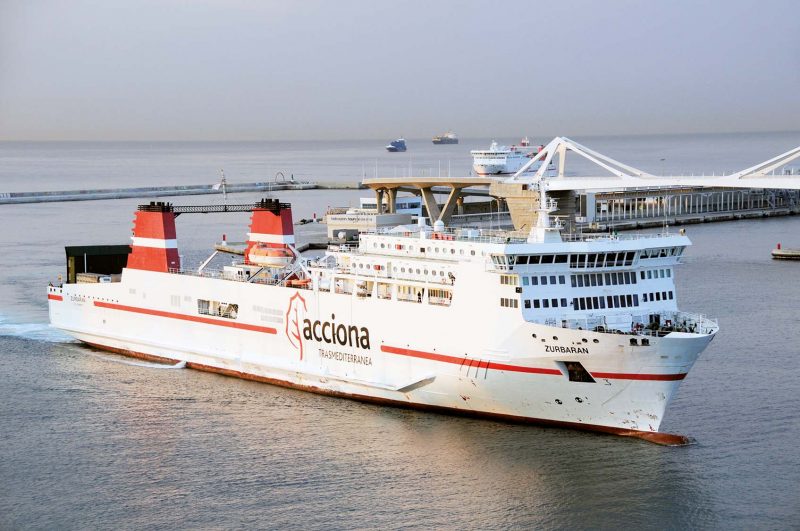
The funnel colours of Acciona Trasmediterranea are red with a thin black top and a white central band, and hull colours are white for all passenger and freight ro-ros with a thin red line together with the company logo in black next to a red leaf logo. The fleet in 2007 consisted of twenty bright, modern and fast ferries on all of its premier island routes, including 48 knot Incat wave piercers with capacity for 900 passengers and 280 cars. Milenium and Milenium Dos operated a fast Barcelona to Palma service, with Milenium Tres on the Almeria and Malaga to Melilla route in Africa. In July 2006, Trasmediterranea took over rival ferry company Euroferrys on the Straits of Gibraltar routes after the sale was cleared by the Spanish authorities. A short lived service to Portsmouth from Bilbao in 2007 using the big passenger ferry Fortuny was underutilised and soon withdrawn.
In April 2009, an EU subsidy of €30 million was awarded to ‘La Tras’ for a Vigo to St. Nazaire, Nantes and Le Havre freight link with four weekly sailings to help trucks bypass the congested Pyrenees road links. A new ro-ro cargo service had begun twelve months earlier between Barcelona and Tangiers to carry a significant portion of the Moroccan fruit and vegetable harvest on the return voyage on company freight ro-ros. The company freight routes to the Canaries from Barcelona and Algeciras on a trio of ‘Super Fast’ freight ro-ros were showing significant increases in cargo carried and profits. The company continued to look for new freight ro-ro routes, including to Italy in partnership with Grimaldi, and also to Algeria from the port of Almeria.
A serious fire occurred on 28th April 2015 on the chartered Grimaldi ferry Sorrento, completed in 2003 as Eurostar Valencia, when she was fifteen miles from Palma on Mallorca after a crossing from Valencia. She had 156 passengers and crew on board, and after the fire on her car deck flared up, they were rescued from lifeboats by passing ships with some airlifted off by helicopter, but unfortunately four crew members were badly injured. She had been chartered to Acciona during the previous year and the completely burnt out hull was eventually towed into Sagunto on 6th May after many ports had refused to allow her entry as she was in danger of sinking. Scandola was another chartered ropax built in 1993 in Holland and previously sailed under the names of Ionian Star and Via Ligure, and sailed for ‘La Tras’ on the Valencia to Ibiza route in 2015 with accommodation for 363 passengers and two hundred cars.

In 2017, the current fleet of twenty ferries operates regular Cadiz to Canaries, inter Canarian, Balearic, Northern Africa and Straits of Gibraltar services. Four fast ferries are owned, with Alboran, Alcantara Dos, Almudaina Dos and Milenium Dos operated on various routes, and four freight ro-ros in Jose Maria Entrecanales, Super Fast Baleares, Super Fast Galicia and Super Fast Levante, all with a lane length of 3,400 metres. There are a dozen large passenger and car ferries operated by Acciona, with the ‘super ferries’ of Sorolla and Fortuny of 26,912 grt as the flagships of the fleet. The passenger ferries are:-
- Sorolla has accommodation for 1,000 passengers and 330 cars and was completed in 2003 with a service speed of 23 knots and has recently operated on Cadiz to Canarian, and on the Balearics routes to Palma and Mahon from Valencia.
- Fortuny has accommodation for 1,000 passengers and 330 cars and was completed in 2001 with a service speed of 23 knots and is operating on the Malaga to Melilla route.
- Albayzin of 26,400gt has accommodation for 950 passengers and 190 cars and was completed in 2004 with a service speed of 22 knots.
- Almariya was built as Olau Hollandia for Olau Line in 1981 and has accommodation for 1,865 passengers and 400 cars with a service speed of 20 knots.
- Ciudad de Malaga of 8,845gt was built in 1998 as Julian Besteiro with accommodation for 943 passengers and 300 cars and 16.5 knots. She has a very curious ‘wraparound’ bridge placed high up ‘midships above her built up decks, with twin funnels aft.
- Juan J. Sister of 22,409gt with accommodation for 550 passengers and 150 cars and was completed in 1993 as the flagship of the fleet for Cadiz to Canaries service, but has been operating on the Almeria and Malaga to Melilla route since 2014.
- Las Palmas de Gran Canaria of 10,473gt was completed in 1993 with accommodation for 400 passengers and 280 cars on the Cadiz to Canaries route, her sister Santa Cruz de Tenerife has recently been sold.
- Tenacia of 25,757gt is a ‘Visentini’ type ropax built in Italy in 2008 with accommodation for 869 passengers and 195 cars and a service speed of 24 knots.
- Forza of 25,518gt is a ‘Visentini’ type ropax built in Italy in 2010 for Anek Line service in Greece, and is currently operating inter Canarian ferry services with accommodation for 969 passengers and 195 cars and a service speed of 24 knots.
- Adriatico of 31,910gt is a multi deck traditional passenger ferry built in 1986 by Van der Giessen in Holland as SNAV Adriatico for Italian ferry services. She was chartered after the fire on Sorrento in April 2015 and has accommodation for 1,320 passengers and 120 cars with a service speed of 21 knots.
- Vronskiy is an older ferry built in 1978 of 13,505gt with accommodation for 1,256 passengers and 280 cars and a service speed of 17 knots and was operating from Almeria to Oran in 2014.
- Zurbaran of 24,046gt was completed in 2000 with accommodation for 590 passengers and fifty cars and a service speed of 21 knots, and was operating from Barcelona to the Balearics islands in 2014.
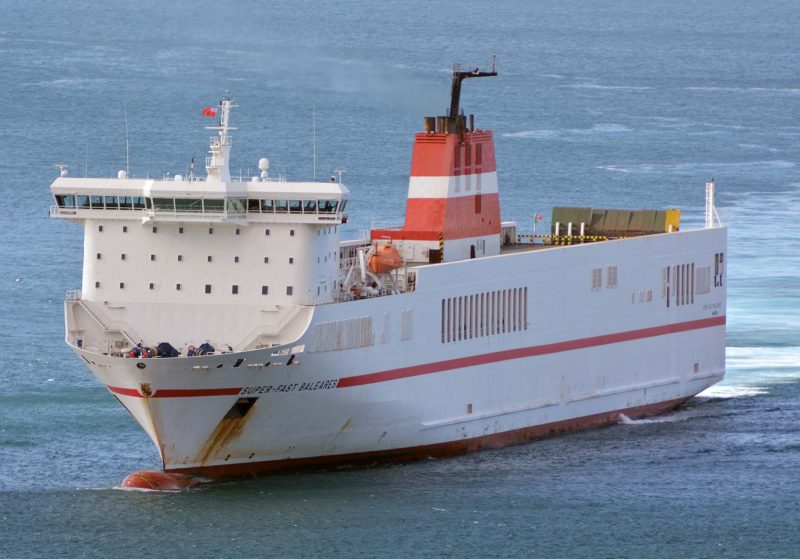
CENTENARY CELEBRATIONS
The centenary celebrations started in November 2016 and have continued right through 2017, with all twenty ferries painted with stylised red ‘100 and 1917-2017’ above the word ‘Trasmediterranea’ in the middle of both sides of their white hulls. The company sent out a Christmas card with a colour painting of a ferry of the 1950s to all employees, with best wishes for peace, happiness and friendship during 2017, the year of the centenary. A special webpage was created at www.trasmeships.es for all Trasmediterranea aficionados to enjoy. A long video was created of all the many company ferries that have docked at the beautiful port of Mahon on Menorca during the last one hundred years. An exhibition of company photographs was held in the Museo de Castillo de San Carlos in Palma (Mallorca) from 20th January 2017 to 12th February 2017.

The Madrid Naval Museum has an exhibition of 100 Years of Trasmedit-erranea and open throughout 2017.
Messages of congratulation were sent by Managing Director Mario Quero Gil, and received at the Madrid headquarters of the company from many Spanish dignatories. It has been a very eventful first hundred years, and I also would like to send my congratulations and best wishes on the centenary of Trasmediterranea, and look forward to the next one hundred years and the bicentenary.

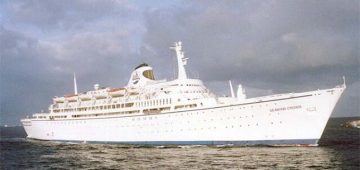
Comments
Sorry, comments are closed for this item